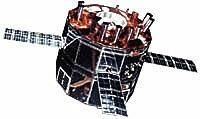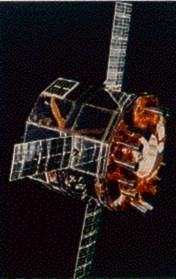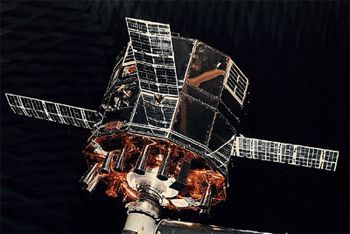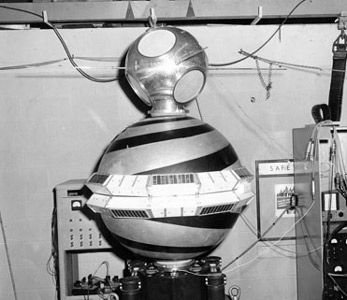
Home - Search - Browse - Alphabetic Index: 0- 1- 2- 3- 4- 5- 6- 7- 8- 9
A- B- C- D- E- F- G- H- I- J- K- L- M- N- O- P- Q- R- S- T- U- V- W- X- Y- Z
Solrad
 Solrad 11 Credit: US Navy |
Status: Operational 1968. First Launch: 1968-03-05. Last Launch: 1976-03-15. Number: 4 . Gross mass: 170 kg (370 lb).
Conceived by the Space Science Division as a means of measuring and analyzing Solar Radiation, twelve SOLRAD satellites were successfully launched between June 1960 and March 1976. The first SOLRAD had an immediate scientific impact. Equipped with both X-ray and Lyman-alpha sensors, SOLRAD I quickly determined that radio fade-outs were caused by solar X-ray emissions. Subsequent SOLRADs also had important, although not quite so dramatic, scientific payoffs.
By 1972 the SolRad series satellite had grown from a 19 kg polished aluminum ball measuring 51 cm in diameter and with a useful lifetime of 10 months, to a 118 kg 12-sided cylinder measuring 76 cm x 58 cm and with a seven year life.
The SolRad satellite carried a classified ELINT payload, called Grab. It was kept secret for nearly 40 years, until its existence was revealed by the Director of the National Reconnaissance Organization (NRO) during NRL's 75th anniversary jubilee events.
NASA NSSDC Master Catalog Description
This NRL satellite was one of the SOLRAD series that began in 1960 to provide continuous coverage of solar radiation with a set of standard photometers. SOLRAD 9 was a spin-stabilized satellite oriented with its spin axis perpendicular to the sun-satellite line so that the 14 solar X-ray and UV photometers pointing radially outward from its equatorial belt viewed the sun with each revolution. Data were simultaneously transmitted via FM/AM telemetry and recorded in a core memory that read out its contents on command. Individual scientists and institutions were invited to receive and use the data transmitted on the 136-MHz telemetry band on the standard IRIG channels 3 through 8. For the period July 1971 to June 1973, the core memory data of SOLRAD 10 were used rather than those from SOLRAD 9. The SOLRAD 10 core memory failed June 11, 1973, and SOLRAD 9 was heavily used until February 25, 1974, when the gas supply of the attitude control system was exhausted. Lacking attitude control, SOLRAD 9 was operationally useless and was turned off. For more details, see R. W. Kreplin and D. M. Horan, "The NRL SOLRAD 9 Satellite Solar Explorer B 1968-17A," NRL Report 6800, 1969.
NASA NSSDC Master Catalog Description
SOLRAD 10, a spin-stabilized satellite, was one of the SOLRAD series designed to provide continuous coverage of wavelength and intensity changes in solar radiation in the UV, soft, and hard X-ray regions. SOLRAD 10 also mapped the celestial sphere using a high-sensitivity X-ray detector. The spacecraft was a 12-sided cylinder that measured 76 cm in diameter and 58 cm in height. Four symmetrically placed 17.8-by 53.3-cm solar cell panels, hinged at the central section of the structure, served as the elements of a turnstile antenna system. Eighteen solar sensors were mounted pointing parallel to the spin axis of the satellite, which pointed directly at the solar disk. The plane of rotation shifted about 1 deg/day so that a stellar detector mounted to point radially outward from the axis scanned the celestial sphere. Data from all detectors were stored in a 54-kbs core memory and telemetered on command to the NRL tracking station at Blossom Point, MD. Data were also transmitted in real time at 137.710 MHz. For additional information, see Naval Res. Review, v. 25, p. 1, 1971.
NASA NSSDC Master Catalog Description
The NRL SOLRAD 8 satellite was one of the SOLRAD series that began in 1960 to provide continuous coverage of solar radiation with a set of standard photometers. SOLRAD 8 was a spin-stabilized satellite oriented with its spin axis perpendicular to the sun-satellite line so that the 14 solar X-ray and ultraviolet photometers pointing radially outward from its equatorial belt viewed the sun with each revolution. Data were transmitted in real time by means of an FM/AM telemetry system and were recorded by the stations on the STADAN tracking network. The satellite performed normally except for the spin system, which failed to maintain 60 rpm (at spin rates below 10 rpm data reduction became difficult). The spin rate gradually decreased to 4 rpm on September 12, 1966. At that time, ground command succeeded in reactivating spinup to 78 rpm, which exhausted the gas supply. From this point, the spin rate gradually decreased to 10 rpm in August 1967, when data collection was substantially decreased.
More at: Solrad.
| Solrad Model Vehicle evaluation payload built by Naval Research Laboratory (NRL) for Naval Research Laboratory (NRL) / US Navy, USA. Launched 1960. |
Family: Astronomy, High earth orbit, Solar. Country: USA. Engines: Star 17A. Launch Vehicles: Titan, Titan IIIC, Scout, Scout B. Projects: Explorer. Launch Sites: Wallops Island, Cape Canaveral, Wallops Island LA3A, Cape Canaveral LC40. Agency: USN. Bibliography: 126, 2, 6, 6894, 13115, 13116.
 | Solrad 1 Credit: US Navy |
 | Solrad 10 Credit: US Navy |
 | Solrad 1 Credit: US Navy |
 | LOFTI 2B Credit: Manufacturer Image |
 | Explorer 37 Credit: Manufacturer Image |
 | SE C Credit: Manufacturer Image |
 | Solrad 11A Credit: Manufacturer Image |
 | Solrad Model Credit: Manufacturer Image |
1968 March 5 - . 18:28 GMT - . Launch Site: Wallops Island. Launch Complex: Wallops Island LA3A. LV Family: Scout. Launch Vehicle: Scout B. FAILURE: Partial Failure.. Failed Stage: 4.
- Explorer 37 - . Payload: Solar Explorer B. Mass: 198 kg (436 lb). Nation: USA. Agency: NRL. Program: Explorer. Class: Astronomy. Type: Solar satellite. Spacecraft: Solrad. Decay Date: 1990-11-16 . USAF Sat Cat: 3141 . COSPAR: 1968-017A. Apogee: 433 km (269 mi). Perigee: 353 km (219 mi). Inclination: 59.30 deg. Period: 92.40 min. Solar Explorer B; radiation data; off-nominal orbit..
1971 July 8 - . 22:58 GMT - . Launch Site: Wallops Island. Launch Complex: Wallops Island LA3A. LV Family: Scout. Launch Vehicle: Scout B.
- Explorer 44 - . Payload: Solar Explorer C. Mass: 118 kg (260 lb). Nation: USA. Agency: NRL. Program: Explorer. Class: Astronomy. Type: Solar satellite. Spacecraft: Solrad. Decay Date: 1979-12-15 . USAF Sat Cat: 5317 . COSPAR: 1971-058A. Apogee: 632 km (392 mi). Perigee: 433 km (269 mi). Inclination: 51.10 deg. Period: 95.20 min. Solar radition data. Spacecraft engaged in research and exploration of the upper atmosphere or outer space (US Cat B). .
1976 March 15 - . 01:25 GMT - . Launch Site: Cape Canaveral. Launch Complex: Cape Canaveral LC40. LV Family: Titan. Launch Vehicle: Titan IIIC.
- Solrad 11A - . Mass: 181 kg (399 lb). Nation: USA. Agency: USAF. Class: Astronomy. Type: Solar satellite. Spacecraft: Solrad. USAF Sat Cat: 8748 . COSPAR: 1976-023C. Apogee: 119,180 km (74,050 mi). Perigee: 118,383 km (73,559 mi). Inclination: 25.70 deg. Period: 7,344.30 min. Solar radiation data. Spacecraft engaged in practical applications and uses of space technology such as weather or communication (US Cat C)..
- Solrad 11B - . Mass: 181 kg (399 lb). Nation: USA. Agency: USAF. Class: Astronomy. Type: Solar satellite. Spacecraft: Solrad. USAF Sat Cat: 8749 . COSPAR: 1976-023D. Apogee: 116,645 km (72,479 mi). Perigee: 115,720 km (71,900 mi). Inclination: 25.60 deg. Period: 7,116.70 min. Solar radiation data. Spacecraft engaged in practical applications and uses of space technology such as weather or communication (US Cat C)..
Back to top of page
Home - Search - Browse - Alphabetic Index: 0- 1- 2- 3- 4- 5- 6- 7- 8- 9
A- B- C- D- E- F- G- H- I- J- K- L- M- N- O- P- Q- R- S- T- U- V- W- X- Y- Z
© 1997-2019 Mark Wade - Contact
© / Conditions for Use